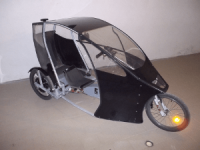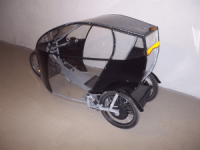Hello, I'm new of this forum. I'm from Italy (so excuse my bad English...).
In the last years I've worked on a cabin bicycle (trike) with pedal assist system according to European pedelec law. It's an utility vehicle (not sport).
Now I'm thinking about producing and selling it, but I would like to understand if it's a possible useful thing or only a dream of mine...
This tricycle is designed to replace bicycles and mopeds (in many cases even the car) in small movements, allowing you to have a good comfort even in case of heavy rain and cold weather, traveling in normal clothes without getting wet and dirty and without sweating with the help of the electric motor. It has the advantage of an enclosed space behind the driver suitable as luggage or carry an adult passenger (inconvenient if high) or a child. The body is completely closed from the left side to protect from splashing water of the other car in the event of rain,it is open below to allow the use of the feet to propel the vehicle in reverse (as a motorcycle) and partially open on the right side to allow easy access and ventilation. All this without license or driving license, road tax, insurance, payment of parking and petrol ... economic, practical and environmentally friendly.
Here some short videos: http://www.youtube.com/watch?v=XKDzj79_pWQ http://www.youtube.com/watch?v=wXILXoK-_s0 http://www.youtube.com/watch?v=dU_WAyQNpDo (note the child in the back seat )
)
Here there is a topic on a Italian e-bike forum (good for see some pictures): http://www.jobike.it/forum/topic.asp?TOPIC_ID=15998
Here some technical data:
The prototype is the "heavy"version with lead acid batteries and two engines: tandem tricycle, steel frame, square tube (section 30mm) and roll bar cage (section 20mm and 12 mm). Amortized rear suspension, front fork suspension, 20 "wheels. Plexyglass and aluminum sheet cover. Dimensions (cm): length 223, width 82, height 117, wheel base 173. Approximate weight 120 kg (base vehicle50+ engines 20 + lead-acid batteries 50). Motor 1: rear hub nine continent 36v 250w operated with PAS limited to 25 km / h (legal). Motor 2 (to be used only in private areas): rear hub nine continent 48v 1350W operated with thumb throttle (max speed 45 km / h). 4x12v Batteries 45 Ah (total theoretical capacity 2160wh). Gearbox 5-speed. V-brakes on all three wheels (provisional as insufficient for the weight of the vehicle will be replaced with hydraulic disc brakes).
Autonomy plan without contribution muscle (by the only movement to operate the PAS) using the motor 250w: 150 Km (80 km recommended not to download too much lead-acid batteries by reducing the cycles of use and useful life). With the use of both engines go up strong climbs.
It has a 160w electric heater to warm the passenger compartment and defrost the windshield and a 12v cigarette lighter socket for accessories (navigation, radio, etc..).
The roof has an area of 0.5 square meters suitable for installation of solar cells for about 50Wp (give energy to walk 5 km per hour of exposure to sunlight).
The "light" version (forthcoming) is easier with a single motor, 36v 10Ah LiFePO4 batteries and a few differences compared to "heavy" weight halved (total about 65 kg), motor 1: nine continent hub rear 36v 250w operated with PAS limited to 25 km / h, Autonomy 35 km (expandable battery packs with higher capacity, accounting for about 300 euros and 5 kg for other 35 km of extra autonomy ). The devices are not available in 12v (heater and cigarette lighter). Not recommended for strong climbs. The batteries can be easily removed to be charged into the house while the vehicle is parked on the street (recommended a car alarm). Can be easily parked even vertically on a surface of cm117x82 (on a bike rack for motorhome there they would be two). The idea is to be able to sell this trike around 2500 or 3000 euros.
In the last years I've worked on a cabin bicycle (trike) with pedal assist system according to European pedelec law. It's an utility vehicle (not sport).
Now I'm thinking about producing and selling it, but I would like to understand if it's a possible useful thing or only a dream of mine...
This tricycle is designed to replace bicycles and mopeds (in many cases even the car) in small movements, allowing you to have a good comfort even in case of heavy rain and cold weather, traveling in normal clothes without getting wet and dirty and without sweating with the help of the electric motor. It has the advantage of an enclosed space behind the driver suitable as luggage or carry an adult passenger (inconvenient if high) or a child. The body is completely closed from the left side to protect from splashing water of the other car in the event of rain,it is open below to allow the use of the feet to propel the vehicle in reverse (as a motorcycle) and partially open on the right side to allow easy access and ventilation. All this without license or driving license, road tax, insurance, payment of parking and petrol ... economic, practical and environmentally friendly.
Here some short videos: http://www.youtube.com/watch?v=XKDzj79_pWQ http://www.youtube.com/watch?v=wXILXoK-_s0 http://www.youtube.com/watch?v=dU_WAyQNpDo (note the child in the back seat
Here there is a topic on a Italian e-bike forum (good for see some pictures): http://www.jobike.it/forum/topic.asp?TOPIC_ID=15998
Here some technical data:
The prototype is the "heavy"version with lead acid batteries and two engines: tandem tricycle, steel frame, square tube (section 30mm) and roll bar cage (section 20mm and 12 mm). Amortized rear suspension, front fork suspension, 20 "wheels. Plexyglass and aluminum sheet cover. Dimensions (cm): length 223, width 82, height 117, wheel base 173. Approximate weight 120 kg (base vehicle50+ engines 20 + lead-acid batteries 50). Motor 1: rear hub nine continent 36v 250w operated with PAS limited to 25 km / h (legal). Motor 2 (to be used only in private areas): rear hub nine continent 48v 1350W operated with thumb throttle (max speed 45 km / h). 4x12v Batteries 45 Ah (total theoretical capacity 2160wh). Gearbox 5-speed. V-brakes on all three wheels (provisional as insufficient for the weight of the vehicle will be replaced with hydraulic disc brakes).
Autonomy plan without contribution muscle (by the only movement to operate the PAS) using the motor 250w: 150 Km (80 km recommended not to download too much lead-acid batteries by reducing the cycles of use and useful life). With the use of both engines go up strong climbs.
It has a 160w electric heater to warm the passenger compartment and defrost the windshield and a 12v cigarette lighter socket for accessories (navigation, radio, etc..).
The roof has an area of 0.5 square meters suitable for installation of solar cells for about 50Wp (give energy to walk 5 km per hour of exposure to sunlight).
The "light" version (forthcoming) is easier with a single motor, 36v 10Ah LiFePO4 batteries and a few differences compared to "heavy" weight halved (total about 65 kg), motor 1: nine continent hub rear 36v 250w operated with PAS limited to 25 km / h, Autonomy 35 km (expandable battery packs with higher capacity, accounting for about 300 euros and 5 kg for other 35 km of extra autonomy ). The devices are not available in 12v (heater and cigarette lighter). Not recommended for strong climbs. The batteries can be easily removed to be charged into the house while the vehicle is parked on the street (recommended a car alarm). Can be easily parked even vertically on a surface of cm117x82 (on a bike rack for motorhome there they would be two). The idea is to be able to sell this trike around 2500 or 3000 euros.



